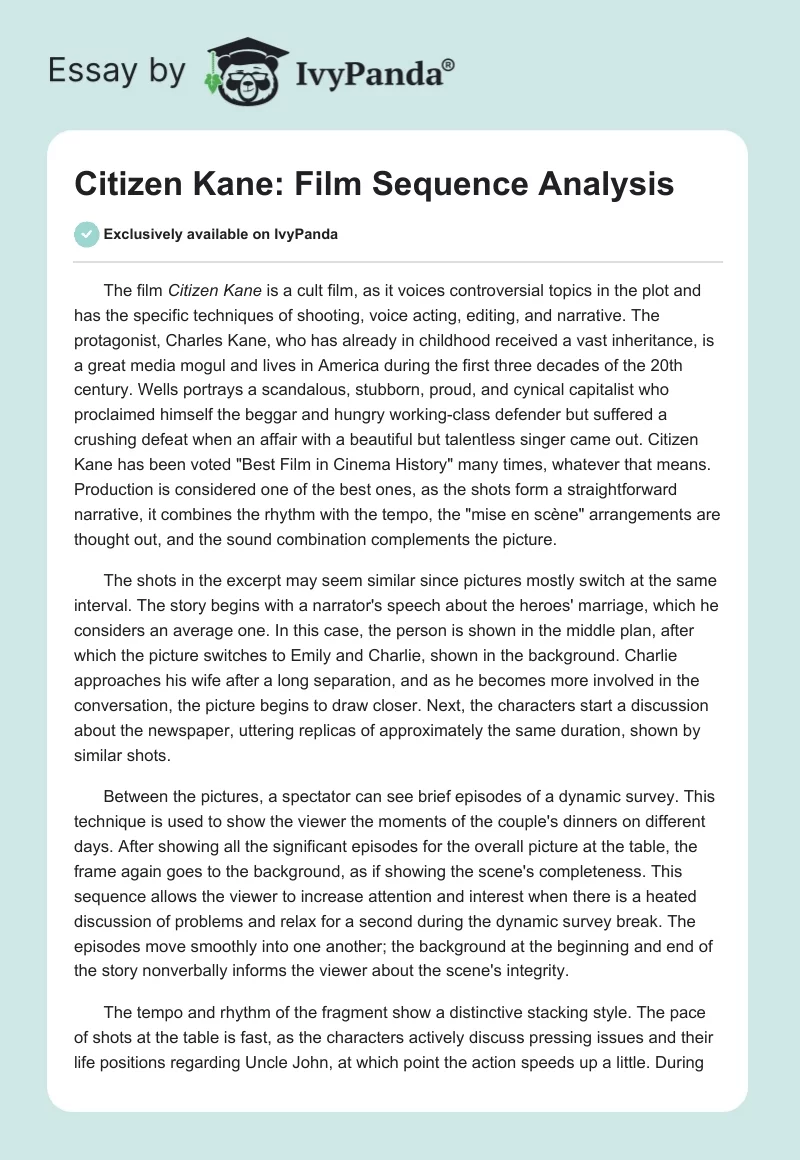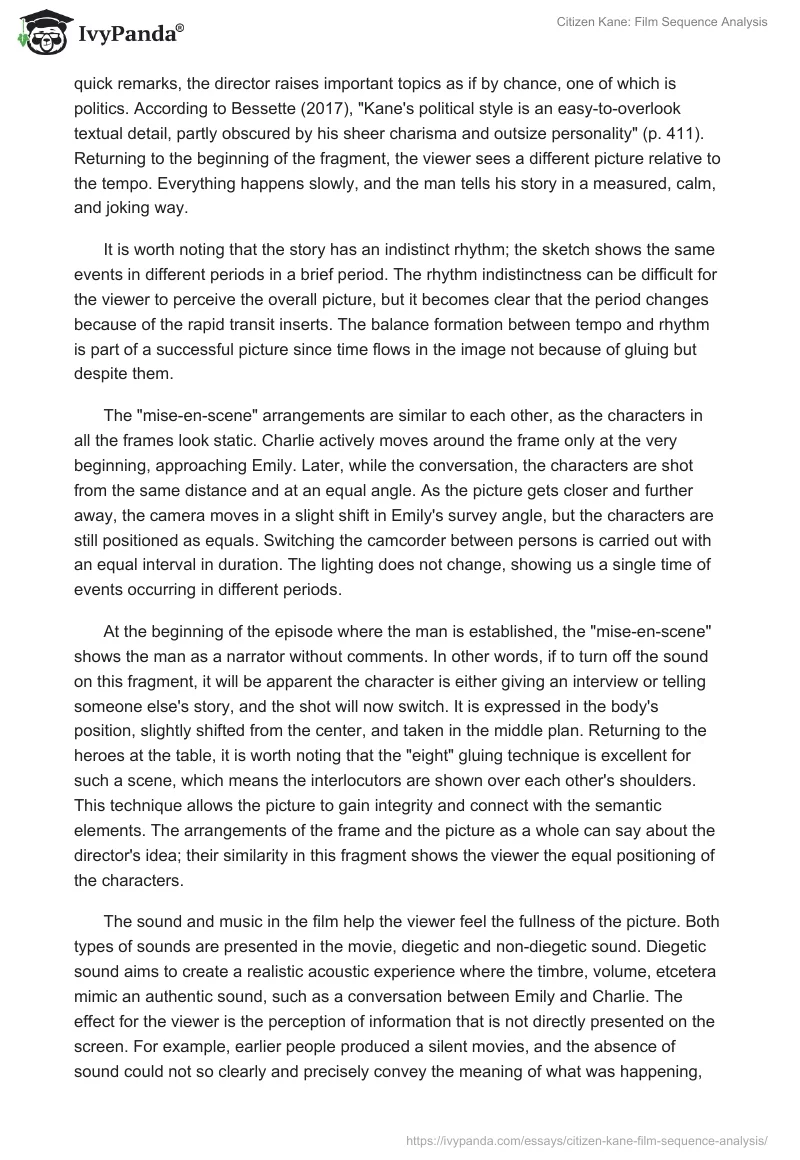The film Citizen Kane is a cult film, as it voices controversial topics in the plot and has the specific techniques of shooting, voice acting, editing, and narrative. The protagonist, Charles Kane, who has already in childhood received a vast inheritance, is a great media mogul and lives in America during the first three decades of the 20th century. Wells portrays a scandalous, stubborn, proud, and cynical capitalist who proclaimed himself the beggar and hungry working-class defender but suffered a crushing defeat when an affair with a beautiful but talentless singer came out. Citizen Kane has been voted “Best Film in Cinema History” many times, whatever that means. Production is considered one of the best ones, as the shots form a straightforward narrative, it combines the rhythm with the tempo, the “mise en scène” arrangements are thought out, and the sound combination complements the picture.
The shots in the excerpt may seem similar since pictures mostly switch at the same interval. The story begins with a narrator’s speech about the heroes’ marriage, which he considers an average one. In this case, the person is shown in the middle plan, after which the picture switches to Emily and Charlie, shown in the background. Charlie approaches his wife after a long separation, and as he becomes more involved in the conversation, the picture begins to draw closer. Next, the characters start a discussion about the newspaper, uttering replicas of approximately the same duration, shown by similar shots.
Between the pictures, a spectator can see brief episodes of a dynamic survey. This technique is used to show the viewer the moments of the couple’s dinners on different days. After showing all the significant episodes for the overall picture at the table, the frame again goes to the background, as if showing the scene’s completeness. This sequence allows the viewer to increase attention and interest when there is a heated discussion of problems and relax for a second during the dynamic survey break. The episodes move smoothly into one another; the background at the beginning and end of the story nonverbally informs the viewer about the scene’s integrity.
The tempo and rhythm of the fragment show a distinctive stacking style. The pace of shots at the table is fast, as the characters actively discuss pressing issues and their life positions regarding Uncle John, at which point the action speeds up a little. During quick remarks, the director raises important topics as if by chance, one of which is politics. According to Bessette (2017), “Kane’s political style is an easy-to-overlook textual detail, partly obscured by his sheer charisma and outsize personality” (p. 411). Returning to the beginning of the fragment, the viewer sees a different picture relative to the tempo. Everything happens slowly, and the man tells his story in a measured, calm, and joking way.
It is worth noting that the story has an indistinct rhythm; the sketch shows the same events in different periods in a brief period. The rhythm indistinctness can be difficult for the viewer to perceive the overall picture, but it becomes clear that the period changes because of the rapid transit inserts. The balance formation between tempo and rhythm is part of a successful picture since time flows in the image not because of gluing but despite them.
The “mise-en-scene” arrangements are similar to each other, as the characters in all the frames look static. Charlie actively moves around the frame only at the very beginning, approaching Emily. Later, while the conversation, the characters are shot from the same distance and at an equal angle. As the picture gets closer and further away, the camera moves in a slight shift in Emily’s survey angle, but the characters are still positioned as equals. Switching the camcorder between persons is carried out with an equal interval in duration. The lighting does not change, showing us a single time of events occurring in different periods.
At the beginning of the episode where the man is established, the “mise-en-scene” shows the man as a narrator without comments. In other words, if to turn off the sound on this fragment, it will be apparent the character is either giving an interview or telling someone else’s story, and the shot will now switch. It is expressed in the body’s position, slightly shifted from the center, and taken in the middle plan. Returning to the heroes at the table, it is worth noting that the “eight” gluing technique is excellent for such a scene, which means the interlocutors are shown over each other’s shoulders. This technique allows the picture to gain integrity and connect with the semantic elements. The arrangements of the frame and the picture as a whole can say about the director’s idea; their similarity in this fragment shows the viewer the equal positioning of the characters.
The sound and music in the film help the viewer feel the fullness of the picture. Both types of sounds are presented in the movie, diegetic and non-diegetic sound. Diegetic sound aims to create a realistic acoustic experience where the timbre, volume, etcetera mimic an authentic sound, such as a conversation between Emily and Charlie. The effect for the viewer is the perception of information that is not directly presented on the screen. For example, earlier people produced a silent movies, and the absence of sound could not so clearly and precisely convey the meaning of what was happening, so there were restrictions on shooting a visual format. Diegetic sound is also an integral part of understanding the plot, and its function can not be separated from the visual image.
The non-diegetic sound is expressed in the narrator’s tale of the wedding and the characters and the music. The voice-over aims to comment on what is happening inside the screen world specifically for the viewer, providing him with considerable information, such as enhancing emotions when spouses talk. Non-diegetic music is designed to create an emotional impact: creating tension, emphasizing the drama of a situation, etcetera. Wehrs and Blake (2017) note, “Music can influence our perception of a film like nothing else, elevating the viewer to a new emotional plane” (p. 735). Sound can not work autonomously because it is crucial for a film to feel realistic to the audience. It improves the function of visual elements and is an integral part of creating the frame’s completeness. Music and sound half make the film a success, as they help the person experience the atmosphere entirely.
Owing to a talented director’s idea and specialists’ teamwork, the film became one of the best in history. The excerpt shots are kindred, but some transitions do not let the viewer get bored even here. Rhythm and tempo exhibit a distinctive overlay technique, and together they form an artistic spectacle. The “mise-en-scene” almost does not change; the characters are shot at the same angle and lighting during the conversation. Sound, music, and the speaker’s speech help a viewer immerse entirely in the atmosphere and feel the heroes’ emotions. The picture is contradictory in its plot, but the film crew, director, and producer’s work are done to the greatest extent.
References
Bessette, E. (2017). Mulvey and Trump on Citizen Kane. New Review of Film and Television Studies, 15(4), 410–414. Web.
Wehrs, D. R., & Blake, T. (Eds.) (2017). The palgrave handbook of affect studies and textual criticism. Springer Publishing.


